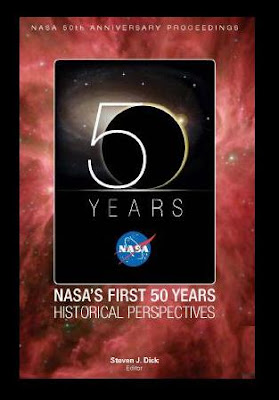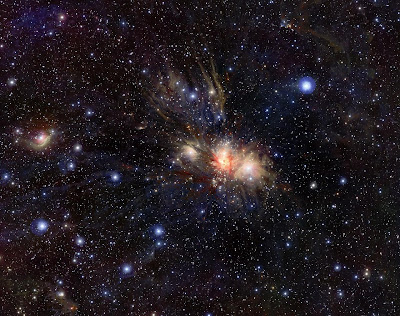
lundi 28 mars 2011
How Large is the Universe?
The mind-blowing answer comes from a theory describing the birth of the universe in the first instant of time.
The universe has long captivated us with its immense scales of distance and time.
How far does it stretch? Where does it end... and what lies beyond its star fields... and streams of galaxies extending as far as telescopes can see?
These questions are beginning to yield to a series of extraordinary new lines of investigation... and technologies that are letting us to peer into the most distant realms of the cosmos...
But also at the behavior of matter and energy on the smallest of scales.
Remarkably, our growing understanding of this kingdom of the ultra-tiny, inside the nuclei of atoms, permits us to glimpse the largest vistas of space and time.
In ancient times, most observers saw the stars as a sphere surrounding the earth, often the home of deities.
The Greeks were the first to see celestial events as phenomena, subject to human investigation... rather than the fickle whims of the Gods.
One sky-watcher, for example, suggested that meteors are made of materials found on Earth... and might have even come from the Earth.
Those early astronomers built the foundations of modern science. But they would be shocked to see the discoveries made by their counterparts today.
The stars and planets that once harbored the gods are now seen as infinitesimal parts of a vast scaffolding of matter and energy extending far out into space.
Just how far... began to emerge in the 1920s.
Working at the huge new 100-inch Hooker Telescope on California's Mt. Wilson,
astronomer Edwin Hubble, along with his assistant named Milt Humason, analyzed the light of fuzzy patches of sky... known then as nebulae.
They showed that these were actually distant galaxies far beyond our own.
Hubble and Humason discovered that most of them are moving away from us. The farther out they looked, the faster they were receding.
This fact, now known as Hubble's law, suggests that there must have been a time when the matter in all these galaxies was together in one place.
That time... when our universe sprung forth... has come to be called the Big Bang.
How large the cosmos has gotten since then depends on how long its been growing... and its expansion rate.
Recent precision measurements gathered by the Hubble space telescope and other instruments have brought a consensus...
That the universe dates back 13.7 billion years.
Its radius, then, is the distance a beam of light would have traveled in that time ... 13.7 billion light years.
That works out to about 1.3 quadrillion kilometers.
In fact, it's even bigger.... Much bigger. How it got so large, so fast, was until recently a deep mystery.
That the universe could expand had been predicted back in 1917 by Albert Einstein, except that Einstein himself didn't believe it...
until he saw Hubble and Humason's evidence.
Einstein's general theory of relativity suggested that galaxies could be moving apart because space itself is expanding.
So when a photon gets blasted out from a distant star, it moves through a cosmic landscape that is getting larger and larger, increasing the distance it must travel to reach us.
In 1995, the orbiting telescope named for Edwin Hubble began to take the measure of the universe... by looking for the most distant galaxies it could see.
Taking the expansion of the universe into account, the space telescope found galaxies that are now almost 46 billion light years away from us in each direction... and almost 92 billion light years from each other.
And that would be the whole universe... according to a straightforward model of the big bang.
But remarkably, that might be a mere speck within the universe as a whole, according to a dramatic new theory that describes the origins of the cosmos.
It's based on the discovery that energy is constantly welling up from the vacuum of space in the form of particles of opposite charge... matter and anti-matter.
mardi 11 janvier 2011
lundi 8 novembre 2010
dimanche 3 octobre 2010
samedi 11 septembre 2010
samedi 4 septembre 2010
Progress in Development of the Axel Rovers


Author(s): Nesnas, Issa A.; Helmick, Daniel M.; Volpe, Richard A.; Abad-Manterola, Pablo; Edlund, Jeffrey A.
Abstract:
Progress has been made in the development of a family of robotic land vehicles having modular and minimalist design features chosen to impart a combination of robustness, reliability, and versatility. These vehicles at earlier stages of development were described in two previous NASA Tech Briefs articles: "Reconfigurable Exploratory Robotic Vehicles" (NPO-20944), Vol. 25, No. 7 (July 2001), page 56; and "More About Reconfigurable Exploratory Robotic Vehicles" (NPO-30890), Vol. 33, No. 8 (August 2009), page 40. Conceived for use in exploration of the surfaces of Mars and other remote planets, these vehicles could also be adapted to terrestrial applications, including exploration of volcanic craters or other hostile terrain, military reconnaissance, inspection of hazardous sites, and searching for victims of earthquakes, landslides, avalanches, or mining accidents. In addition, simplified versions of these vehicles might be marketable as toys. The most basic module in this family of reconfigurable robots is the Axel rover, which has a cylindrical body with two main wheels and a trailing link. Inside its body are three motors and associated mechanisms for driving the two wheels and for rotating the link 360 around its symmetrical body. The actuated link serves several purposes: It is used as a lever arm to react to the wheels thrust to move Axel in multiple directions. It is used to rotate the Axel housing in order to tilt, to the desired angle, any sensors and instruments mounted on or in the Axel housing. It provides an alternative mobility mode, which is primarily used in its tethered configuration. Turn ing the link into the ground in lieu of driving the wheels causes the Axel housing and wheels to roll as a unit and thereby leads to a tumbling motion along the ground. With a tether mounted around Axel s cylindrical body, the link serves as a winch mechanism to reel and unreel the tether raising and lowering Axel over steep and vertical surfaces (Figure 1). Sensors, computation, and communication modules are also housed inside Axel s body. A pair of stereo vision cameras provides three-dimensional view for autonomous navigation and avoiding obstacles. Inertial sensors determine the tilt of the robot and are used for estimating its motion. In a fully developed version, power would be supplied by rechargeable batteries aboard Axel; at the time of reporting the information for this article, power was supplied from an external source via a cable. In and of itself, the Axel rover is fully capable of traversing and sampling terrains on planetary surfaces. By use of only the two main wheel actuators and the caster link actuator, Axel can be made to follow an arbitrary path, turn in place, and operate upside- down or right-side-up. If operated in a tethered configuration, as shown in Figure 1, it can be made to move down and up a steep crater wall, descend from an overhang to a cave, and ascend from the cave back to the overhang, all by use of the same three actuators. Such tethered operation could be useful in searching for accident victims or missing persons in mines, caves, and rubble piles. Running the tether through the caster link enhances the stability of Axel and provides a restoring force that keeps the link off the ground for the most part during operation on a steep slope. In its extended configuration, two Axel modules can dock to either side of a payload module to form the four wheeled Axel2 rover (Figure 2). Additional payload and Axel modules can dock to either side of the Axel2 to form the Axel3 rover, extending its payload capacity and its mobility capabilities.
NASA Center: Jet Propulsion Laboratory
Publication Date: August 2010
Document Source: CASI
Document ID: 20100028898
Publication Information: NASA Tech Briefs, August 2010, 26-27,
Number of Pages = 2
Report Number: NPO-45553
To upload the pdf documentm, click on the title.
See also :
New Prototype Rover For Lunar And Mars Missions Demonstrated
NASA's First 50 Years: Historical Perspectives

Abstract:
Topics covered include: NASA at 50; Inside NASA at 50; Imagining an Aerospace Agency in the Atomic Age; Leading in Space 50 Years of NASA Administrators; Space Access: NASA's Role in Developing Core Launch-Vehicle Technologies; NASA's International Relations in Space An Historical Overview; Fifty Years of NASA and the Public What NASA What Publics; NASA Aeronautics A Half Century of Accomplishments; Evolution of Aeronautics Research at NASA; The NACA, NASA, and the Supersonic-Hypersonic Frontier; Fifty Years of Human Spaceflight Why Is There Still a Controversy; From the Secret of Apollo to the Lessons of Failure The Uses and Abuses of Systems; Engineering and Project Management at NASA; The "Von Braun Paradigm" and NASA's Long-Term Planning for Human Spaceflight; Life Sciences and Human Spaceflight; Voyages to Mars; The Space Age and Disciplinary Change in Astronomy; Planetary Exploration in the Inner Solar System; NASA's Voyages to the Outer Solar System; Deep Space Navigation, Planetary Science, and Astronomy A Synergetic Relationship; NASA's Earth Science Program The Space Agency's Mission to Our Home Planet; Earth Observations from Space Achievements, Challenges, and Realities; Earth Science and Planetary Science A Symbiotic Relationship; and Exploration, Discovery, and Culture NASA's Role in History.
Publication Information:
Number of Pages = 777
Updated/Added to NTRS: 2010-08-30
To download the book click on the title.

Radiometric Chronology of Moon and Mars

Title: Radiometric Chronology of Moon and Mars
Author(s): Nyquist, Laurence E.; Bogard, Donald D.; Shih, Chi-Yu
Abstract: In this paper we have discussed some aspects of the understanding of solar system chronology as the 20th century ends. Our emphasis has been the chronological evolution of the moon and Mars as planetary bodies. We have presented considerable detail concerning the chronological evolution of the moon and Mars. These studies., along with studies of meteorites, have led both to a deeper understanding of major processes that have acted throughout solar system history and to formulation of other significant questions for future work. Investigations of the chronological history of samples from the moon, Mars, and meteorite parent objects emphasize the value of analyses of samples in terrestrial laboratories for increasing our understanding of the evolution of these solar system objects.
Document ID: 20100029922
Publication Information:
Number of Pages = 120
Report Number: JSC-CN-6235
To download the document of 120 pages, click on the title.
jeudi 2 septembre 2010
Inscription à :
Articles (Atom)





















